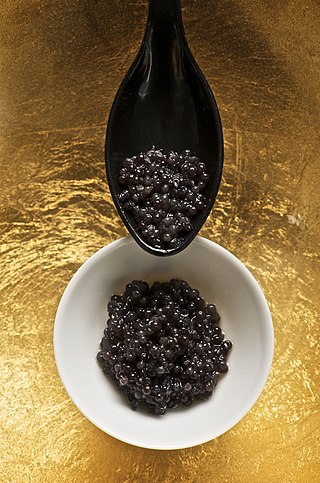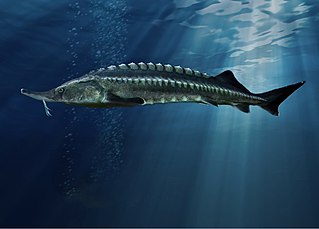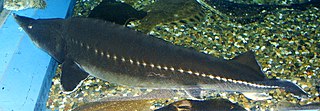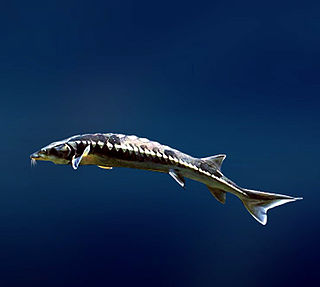Sturgeon is the common name for the 28 species of fish belonging to the family Acipenseridae. The earliest sturgeon fossils date to the Late Cretaceous, and are descended from other, earlier acipenseriform fish, which date back to the Early Jurassic period, some 174 to 201 million years ago. They are one of two living families of the Acipenseriformes alongside paddlefish (Polyodontidae). The family is grouped into four genera: Acipenser, Huso, Scaphirhynchus, and Pseudoscaphirhynchus. Two species may be extinct in the wild, and one may be entirely extinct. Sturgeons are native to subtropical, temperate and sub-Arctic rivers, lakes and coastlines of Eurasia and North America. A Maastrichtian-age fossil found in Morocco shows that they also once lived in Africa.

Caviar is a food consisting of salt-cured roe of the family Acipenseridae. Caviar is considered a delicacy and is eaten as a garnish or spread. Traditionally, the term caviar refers only to roe from wild sturgeon in the Caspian Sea and Black Sea. The term caviar can also describe the roe of other species of sturgeon or other fish such as paddlefish, salmon, steelhead, trout, lumpfish, whitefish, or carp.

Beluga caviar is caviar consisting of the roe of the beluga sturgeon Huso huso. The fish is found primarily in the Caspian Sea, which is bordered by Iran, Azerbaijan, Kazakhstan, Russia, and Turkmenistan. It can also be found in the Black Sea basin and occasionally in the Adriatic Sea. Beluga caviar is the most expensive type of caviar, with market prices ranging from $7,000 to $22,000/kg.

The beluga, also known as the beluga sturgeon or great sturgeon, is a species of anadromous fish in the sturgeon family (Acipenseridae) of the order Acipenseriformes. It is found primarily in the Caspian and Black Sea basins, and formerly in the Adriatic Sea. Based on maximum size, it is the third-most-massive living species of bony fish. Heavily fished for the female's valuable roe, known as beluga caviar, wild populations have been greatly reduced by overfishing and poaching, leading IUCN to classify the species as critically endangered.

The kaluga, also known as the river beluga, is a large predatory sturgeon found in the Amur River basin from Russia to China and near Hokkaido in Japan. With a maximum size of at least 1,000 kg (2,205 lb) and 5.6 m (18 ft), the kaluga is one of the biggest of the sturgeon family. Like the slightly larger beluga, it spends part of its life in salt water. Unlike the beluga, this fish has 5 major rows of dermal scutes and feeds on salmon and other fish in the Amur with its nail like teeth in its jaws. They have gray-green to black backs with a yellowish green-white underbelly.
Acipenser is a genus of sturgeons. With 17 living species, it is the largest genus in the order Acipenseriformes. The genus is paraphyletic, containing all sturgeons that do not belong to Huso, Scaphirhynchus, or Pseudoscaphirhynchus, with many species more closely related to the other three genera than they are to other species of Acipenser. They are native to freshwater and estuarine systems of Eurasia and North America, and most species are threatened. Several species also known to enter near-shore marine environments in the Atlantic, Arctic and Pacific oceans.
Sevruga caviar is one of the highest priced varieties of caviar, eclipsed in cost only by the Beluga and Ossetra varieties. It is harvested from a variety of critically endangered sturgeon fish species, that are known for their small, grey colored eggs. In eastern Europe, it is harvested from the Sevruga sturgeon, the Sterlet sturgeon and the Siberian sturgeon, which are native to the Caspian Sea and the surrounding rivers.

White sturgeon is a species of sturgeon in the family Acipenseridae of the order Acipenseriformes. They are an anadromous (migratory) fish species ranging in the Eastern Pacific; from the Gulf of Alaska to Monterey, California. However, some are landlocked in the Columbia River Drainage, Montana, and Lake Shasta in California, with reported sightings in northern Baja California, Mexico.

The sterlet is a relatively small species of sturgeon from Eurasia native to large rivers that flow into the Black Sea, Azov Sea, and Caspian Sea, as well as rivers in Siberia as far east as Yenisei. Populations migrating between fresh and salt water (anadromous) have been extirpated. It is also known as the sterlet sturgeon.

Fauna of Azerbaijan or animal kingdom of Azerbaijan refers to the diversity of various types of animals, which inhabit and populate a defined ground or water area in Azerbaijan.

The starry sturgeon, also known as the stellate sturgeon or sevruga, is a species of sturgeon. It is native to the Black, Azov, Caspian and Aegean sea basins, but it has been extirpated from the last and it is predicted that the remaining natural population will follow soon due to overfishing.

The Siberian sturgeon is a species of sturgeon in the family Acipenseridae. It is most present in all of the major Siberian river basins that drain northward into the Kara, Laptev and East Siberian Seas, including the Ob, Yenisei Lena, and Kolyma Rivers. It was also found in Kazakhstan and China in the Irtysh River, a major tributary of the Ob, though wild populations are extirpated in China. The species epithet honors the German Russian biologist Karl Ernst von Baer.

The Russian sturgeon, also known as the diamond sturgeon or Danube sturgeon, is a species of fish in the family Acipenseridae. It is found in Azerbaijan, Bulgaria, Georgia, Iran, Kazakhstan, Romania, Russia, Turkey, Turkmenistan, and Ukraine. It is also found in the Caspian Sea. This fish can grow up to about 235 cm (93 in) and weigh 115 kg (254 lb). Russian sturgeon mature and reproduce slowly, making them highly vulnerable to fishing. It is distinguished from other Acipenser species by its short snout with a rounded tip as well as its lower lip which is interrupted at its center.

The bastard sturgeon, also known as the fringebarbel sturgeon, ship sturgeon, spiny sturgeon, or thorn sturgeon, is a species of fish in the family Acipenseridae. These fish are typically found along the benthos of shallower waters near shorelines or estuaries.
Kaluga Queen is a Chinese brand of caviar made by the caviar company Hangzhou Qiandaohu Xunlong Sci-Tech Co., Ltd. The company produces 60 tonnes of caviar annually, making it the largest producer of caviar in the world and responsible for 60% of world production. Kaluga Queen supplies caviar for 21 of the 26 3-starred Michelin restaurants in Paris.

The sturddlefish is a hybrid of the American paddlefish and the Russian sturgeon, accidentally created by researchers in 2019 and announced in 2020. Obtaining living hybrids through breeding individuals from different families is unusual, especially given that the two species' last common ancestor lived 184 million years ago. The hybrids were created accidentally during attempts to induce gynogenesis, a type of parthenogenic reproduction where a sperm cell must be present to trigger embryogenesis but does not genetically contribute to the offspring. Hundreds of hybrid fish were created, of which about two-thirds survived over one month, and about 100 survived for one year. As of July 2020, all living hybrid fish are living in captivity at the research lab in Hungary. There are no current plans to create new sturddlefish.

Exotic and Unusual Fishes of North America is the name of a series of PBS documentary television specials about three species of American fish: The Alligator Gar: Predator or Prey?, The Paddlefish: An American Treasure, and Sturgeon: Ancient Survivors of the Deep. They were presented by KUHT Houston television station, and aired in the United States from 1992 to 1995.













